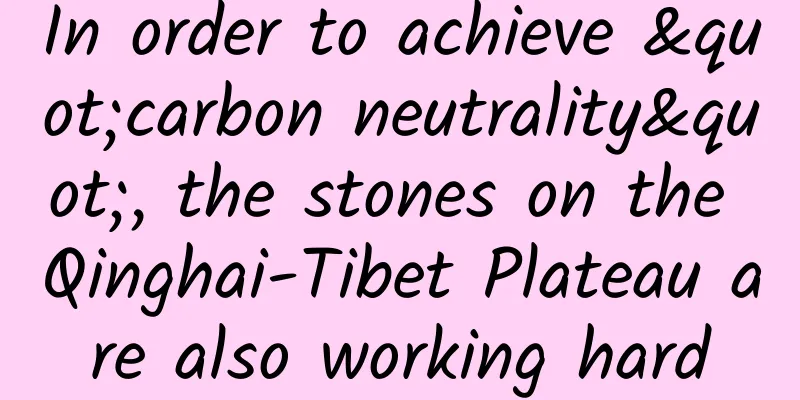In order to achieve "carbon neutrality", the stones on the Qinghai-Tibet Plateau are also working hard

|
When you think of "absorbing carbon dioxide", what do you think of? Trees and oceans may flash into your mind at this moment, and by the way, you may want to go outdoors and get close to nature. However, there is one answer that may often be overlooked, and that is rocks. In the process of capturing and storing atmospheric CO2, it also plays an important role. In order to achieve the goal of "carbon neutrality", the stones of the Qinghai-Tibet Plateau are working hard. What is carbon neutrality? Global warming has become a hot topic of concern to the scientific community and governments of various countries. In response to this issue, governments have proposed relevant goals and plans. In September 2020, Chinese President Xi Jinping delivered an important speech at the 75th United Nations General Assembly, announcing China's carbon neutrality goal. According to the white paper "China Accelerates Low-Carbon Progress" released by Bloomberg New Energy Finance in December 2020, 60% of the world's carbon emissions countries and regions have set carbon neutrality goals, including China, the European Union, the United Kingdom, Japan, South Korea, etc. Carbon neutrality refers to the total amount of CO2 or greenhouse gas emissions directly or indirectly generated by a country, enterprise, product, activity or individual within a certain period of time. By using low-carbon energy to replace fossil fuels, afforestation, energy conservation and emission reduction, etc., the CO2 or greenhouse gas emissions generated by itself can be offset to achieve positive and negative offsets and achieve relative "zero emissions". Simply put, we produce CO2 while consuming it. When the amount we consume and the amount we produce are offset, we achieve zero growth. On the road to achieving carbon neutrality, in addition to countries mainly curbing climate warming through energy conservation and emission reduction and CCS (carbon capture and storage) technology to increase carbon capture and storage, certain physical and chemical processes in nature, such as chemical weathering of rocks, can also capture and store atmospheric CO2, which is called natural CCS. One of the CCS in nature: Chemical weathering of rocks First, we need to understand what chemical weathering of rocks is. Weathering refers to the whole process in nature whereby rocks and minerals on the surface of the earth undergo physical and chemical changes when they come into contact with the atmosphere, water, air, and organisms, thereby forming loose deposits in situ. The process of rock disintegration and fragmentation under physical and mechanical action is called physical weathering, while weathering that can change the chemical composition of rocks is called chemical weathering. Temperature difference weathering causes uneven heating, inconsistent shrinkage, and cracking of rocks Shooting location: Namtso Qugaqie River Basin, Photographer: Yu Zhengliang Oxidation of pyrite in granite (when iron-containing rocks are weathered, they take on a characteristic reddish-brown color, i.e. chemical weathering) Photographed at the Nam Co Qugaqie River Basin, by Yu Zhengliang According to the classification of mineral composition, rocks are mainly divided into silicate rocks and carbonate rocks. Silicate rocks absorb atmospheric CO2 during chemical weathering and then seal CO2 in the form of CaCO3, forming a carbon sink effect on the geological time scale (>1 million years), while carbonate rock weathering can also absorb CO2 from the atmosphere and form a carbon sink on a shorter time scale (<100,000 years) in the form of HCO3-. Simplified model of silicate rock weathering: Simplified model of carbonate rock weathering: As a widespread surface geological process, there is a strong coupling relationship between the chemical weathering of terrestrial rocks and the global carbon cycle and climate change: the rise in atmospheric CO2 concentration leads to global warming, and higher temperatures lead to enhanced chemical weathering of rocks, which in turn increases the amount of CO2 absorbed from the atmosphere, thereby inhibiting the rapid growth of atmospheric CO2 and leading to global cooling, thus forming a negative feedback mechanism. On the other hand, when the earth's temperature is low, the intensity of chemical weathering is also at a low level, and the flux of absorbing atmospheric CO2 is very limited. Therefore, the CO2 emitted by volcanic activity and rock metamorphism can accumulate, which promotes the earth to warm up and prevents the earth's temperature from being too low. It can be seen that the chemical weathering of surface rocks (especially silicate rock weathering) is an important factor in regulating the concentration of atmospheric CO2 and promoting global climate change. It is a "stabilizer" for the evolution of the earth system and is known as the "geological air conditioner". Is the Qinghai-Tibet Plateau a big air conditioner? The Qinghai-Tibet Plateau is high and cold with lack of oxygen and high terrain, and is known as the third pole of the earth. As the "water tower of Asia", the Qinghai-Tibet Plateau has developed numerous glaciers, lakes and rivers. It is far away from the center of human activities and is less affected by human activities. It is a "natural laboratory" for studying the interaction between the various spheres of the earth system. Scientists collect surface water from the Qinghai-Tibet Plateau, such as rivers, lakes, glacier runoff, and measure their chemical composition to reflect the chemical weathering process of the research basin, and then understand the consumption of atmospheric CO2 under weathering. From the perspective of spatial distribution, the uplift of the Himalayas has resulted in abundant precipitation on its southern slopes, but due to terrain obstruction, the climate in the hinterland of the Qinghai-Tibet Plateau is relatively dry. Therefore, although the uplift of the Himalayas has resulted in a higher chemical weathering rate on the southern slopes, the inland drought caused by it has played a negative feedback role on the overall chemical weathering intensity of the Qinghai-Tibet Plateau. From the perspective of annual changes, the seasonal differences in the chemical weathering rate of the inland basins of the Qinghai-Tibet Plateau are very significant, with the monsoon period being much greater than the non-monsoon period. In addition, by comparing the differences in chemical weathering processes and rates between glacial basins and non-glacial basins in the inland of the Qinghai-Tibet Plateau, scientists have concluded that glaciation in the inland of the Qinghai-Tibet Plateau promotes chemical weathering of rocks. In other words, in the inland of the Qinghai-Tibet Plateau, chemical weathering in glacial basins may play a negative feedback role in regulating the increase in CO2 concentration in the atmosphere. **Against the backdrop of global climate change, the warming rate of the Qinghai-Tibet Plateau is twice the global average. **Glaciers are products of climate, and climate warming will inevitably lead to faster melting of glaciers. The chemical weathering of rocks at the spatial scale of watersheds may also be enhanced, thereby strengthening the carbon cycle process in the watersheds. However, **the above theoretical deductions have not yet been verified by field observation data. **In the future, long-term positioning observations of the chemical weathering process and its carbon sink effect in typical glacier basins on the Qinghai-Tibet Plateau are still needed to answer the mystery of what impact glacier changes may have on rock chemical weathering and its carbon sink effect. Changing history of the end of the Azha Glacier tongue in the southeastern Qinghai-Tibet Plateau How to make good use of rock weathering? So, can the important carbon sink function of rock chemical weathering be utilized by humans? The answer to this question is likely to be positive. Some studies have proven that the idea of artificially enhancing the chemical weathering of rocks to curb the rapid growth of atmospheric CO2 concentration is feasible. For example, Beerling et al. believe that by adding crushed basalt or other silicate minerals to the soil,** these substances can provide necessary nutrients such as K and Si for plant growth during chemical weathering, and can also enhance the absorption of atmospheric CO2 (absorb 500-200 million tons of CO2 more per year). ** This technology is simple to operate and low in cost, so promoting this technology in the future can help achieve the ambitious goal of "carbon neutrality" as soon as possible. According to observation data from the National Oceanic and Atmospheric Administration of the United States, the global atmospheric CO2 concentration has increased from 280 ppm before the Industrial Revolution to 416.74 ppm in March 2021. It is urgent to adopt various measures to reduce the concentration of CO2 in the atmosphere and curb the momentum of global warming. Although it is difficult for the general public to directly participate in relevant scientific research, they can still contribute to energy conservation and emission reduction by adjusting their lifestyles and help achieve the goal of "carbon neutrality". References: [1]Beerling, DJ, Kantzas, EP, Lomas, MR et al. Potential for large-scale CO2 removal via enhanced rock weathering with croplands. Nature583, 242–248 (2020). Authors: Yan Ni, Yu Zhengliang, Wu Guangjian, An Baosheng Author unit: Institute of Tibetan Plateau Research, Chinese Academy of Sciences The article was first published in Science Park and only represents the author’s views and does not represent the position of Science Park. Science Academy is the official science popularization micro-platform of the Chinese Academy of Sciences. It is hosted by the Science Communication Bureau of the Chinese Academy of Sciences and operated by the China Science Popularization Expo team. It is committed to in-depth interpretation of the latest scientific research results and scientific voice on hot social events. |
>>: It is beautiful and long-lived, but it brings disaster to its life
Recommend
Share a slimming meal project suitable for women (with methods of attracting traffic and monetization)
During the holidays, I have been doing nothing bu...
ASO promotion and operation experience sharing: Get 1000+ new activations per day on the App Store for free
After this attempt, we can basically draw the fol...
Semiconductor Industry Association: Global chip sales in June 2022 increased by 13.3% year-on-year
The latest statistics released by the Semiconduct...
Huawei once again took the first place in the 5G mobile phone market share list, and its accumulated advantages are obvious
The world is accelerating the construction of 5G ...
The road to money is bleak: When will Bezos' Amazon model end?
Following the huge losses caused by price cuts an...
Mango TV is stuck in the cycle of "old problems"
LeEco's capital chain problem was a hot topic...
Let’s talk about how to increase followers on apps like Tik Tok and Zhihu!
Today let’s talk about the issue of increasing fo...
APP advertising: How to choose the right delivery channel?
If you don’t advertise, you’re waiting for death;...
How to make money by watching video ads on YouTube?
How to make money by watching video ads on YouTub...
I spent 6,000 yuan to buy 165 lipsticks. Friends with dry and chapped lips are finally saved!
The "cliff-like" drop in temperature, t...
Is the ground promotion effect poor? You may be missing channel evaluation
Field promotions through multiple channels requir...
In-depth analysis: How to operate 2B products
A large number of companies and products have bee...
Practical! A complete guide to the medical treatment process for elderly infected people
Source: People's Daily If you have questions ...
User operation: operation skills and channel establishment for user feedback
Before I became a full-time writer, I worked in u...









